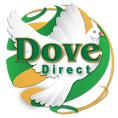Direct Mail in the Age of Coronavirus
Welcome to the Dove Direct Print and Marketing Blog. Today's post, "Direct Mail in the Age of Coronavirus," examines the rise of direct mail marketing over the past few years and why it's a must-have for organizations that need to conquer the digital landscape. As US unemployment nears 40 million, and many remain sheltered-in-place, internet traffic is robust throughout the day, with many sites taking more time to load. The exceptions are those with T1 lines or massive broadband capacity, for example, 500mb download speed.
In 2004, during the infantile stages of the Internet and social media, the average person saw 3-thousand ad impressions per day. By 2020, the number of advertisements had increased from 5k to 10k. As a result, people spend more time dismissing ads rather than reading them. The result, brands need to reach enough prospects online to justify the ad spend.
Our Quote of the Day: "Science clearly shows paper can be more impactful and memorable than digital."
— Forbes Magazine
Digital Marketing's Conundrum
In the past, campaigns and advertisements took days, weeks, or even months to create. Often, these campaigns resulted in hours of grueling work and analysis. Iconic brands with clever ads were able to rise to new heights. Power players like McDonald's, Coca-Cola, Apple, and as far back as Marlboro cigarettes, all displayed creative panache. Those long hours of creative, strategic decisions, for better or for worse, were able to establish several iconic brands that are embedded in our culture.
In the not too distant past, many ad campaigns were designed to capture the attention of the masses. However, those same ads included tertiary targeting so that these ads could garner sales from other significant key demographics. That said, brands and marketers also considered which medium would be the critical ad-media component for each campaign's success. Back in those days, it was quite easy to justify ad spending, due to the limited mediums available. If an ad ran in Time Magazine or ran on a top-rated radio program, all placements could demonstrate the propensity to gain instant credibility. As a distribution channel, those mediums provided supreme authority, and therefore, a readily justifiable spend.
It may appear on the surface that digital marketers and their services are in high demand. As digital marketing has been a boon for many, however, the horizon points to severe challenges ahead.
More for Less
Brands and marketers are well aware that the advertising landscape is undergoing rapid changes. Advertisements and campaigns are running at breakneck speed, flashing and disappearing in the blink of an eye. In every instance where a search, stream, watch, read, scroll, click, or swipe, are invoked, the resulting number of ads that people see is practically untenable. In the social media construct, ads are superfluous, appearing with nearly every click. Given the average 2-hours per day spent on social media, the ads are nonstop.
As a result, consumers have made their adjustments. Most consumers deliberately use a screening process to bypass most ads, unless it's something they need or want. Some digital experts believe that only 100 of every 5000 ad impressions served will be impactful to the target market a brand is attempting to influence. That's about a 2% return of reach.
We contend through our testing that the actual number is closer to 1%. And, we have a proven formula. According to the 1% Thin Theory, only 1% of any target needs a solution when the ad is seen. Further, the 1% Thin Theory suggests that only 1% of the 1% will respond to the advertiser. Therefore, a 5-thousand target market will yield the following: 1% of 5,000 equals 50. 1% of 50 is .5 or half a person. In other words, the brand stands a 50% chance that one person will purchase what is advertised.
That said, the 1% Thin Theory is a benchmark. It's a starting point. You can adjust the theory for multiple needs, including product types, pricing, market penetration, competitive brands, and the overall valuation of the product as it relates to the needs and satisfaction of the consumer set. As benchmarks go, new product launches or product updates could generate as much as 2% or more in a perfect world.
The Mailbox is the Inbox
As recently as 2016, Christmas catalogs featuring music software and hardware, toys, apparel, furniture, gift ideas, exercise/athletic gear, and more, were being mailed to every home.
However, these weren't your average catalogs. These catalogs came with a direct call-to-action. Namely, to redeem a gift card, with a discount-price offering, freebie, or some other incentive.
You should note that the campaigns delivered to a physical mailbox netted a 4.25% response rate, whereas the email version netted less than 0.12%. One example that comes to mind involves the healthcare industry.
Healthcare providers and insurers began using direct mail newsletters to remind folks to get a flu shot. Some providers gave members reward dollars on prepaid cards that could be used for healthcare-related costs, utilities, or everyday items at Walmart. Undoubtedly, as the pandemic continues, healthcare providers may ultimately start using direct mail marketing to deliver testing kits, treatments, vaccines, and more, including changes in medical directives.
Cash Flows Better Via Print
Local and national brands that market via direct mail marketing have demonstrated that this marketing technique works to summon consumer dollars for the intended offers. There are a plethora of reports and surveys conducted by esteemed data research organizations that support how effective direct mail marketing has become.
In 2019, the Canada Post engaged a Canadian neuromarketing firm to compare the effects of paper marketing, aka direct mail pieces, against digital media's email and display ad campaigns. Three results apply to this post and include:
1. Direct mail requires 21% less cognitive effort to process than digital media, suggesting that it is both easier to understand and more memorable.
2. Overall effectiveness, referred to as the motivation-to-cognitive load ratio within the study, showed that direct mail scored an average of 1.31 compared to 0.87 for all digital channels. This is significant because, in this type of test, values greater than 1.0 are indicative of broad in-market success.
3. Further, consumers who received direct mail offers could recall the brand 75% of the time. For consumers who received digital-only versions, the brand was remembered only 44% of the time.
Forbes provided their evaluation of this scientific research with a compelling but straightforward statement; "Science clearly shows paper can be more impactful and memorable than digital."
Further, the Direct Marketing Association has also published its research that raises direct mail marketing to a higher valued marketing tool. Moreover, the most recent edition of the DMA Response Rate Report indicates that direct mail offers a "strong return on marketing investment," with an average ROI of 15% to 17%. In addition, the DMA also highlighted that oversized mailers, such as postcards, have the best response rates, at up to 4.25%, albeit with a targeted mailing list.
The Net-Net
The coronavirus will be with us for months and possibly years to come. As we adapt to a new normal, reaching people in a timely but effective manner will be challenging. With concern regarding falsehoods and fake news, direct mail marketing represents a bright light that effectively breaks through the digital clutter. Research has shown that marketers experience increases when they pair digital marketing with direct mail marketing. The benefits of pairing digital and direct mail include higher consumer trust, improved reach, and higher response rates. If your organization is looking for improved response and engagement rates, then direct mail marketing is an essential marketing tool, especially in the age of the coronavirus. Thanks for reading the "Direct Mail in the Age of Coronavirus."
Let's have a conversation about integrated business solutions and how they can help grow your business, change behavior, and improve the customer experience.
Let us show you how to improve your document processes to optimize your workflow, reduce your costs, and maximize your organization's printing, letter shop, and mailing capabilities. Dove Direct does have an official USPS certified bureau located within our offices that will save you time and money. And, if you bring us your files, we will create a demo file for you. For more information, call Carla Eubanks at 404-629-0122 or email Carla at This email address is being protected from spambots. You need JavaScript enabled to view it..
Dove Direct, your Atlanta based print and mail solutions provider, offers organizations end-to-end data, printing, and mailing solutions: Data Management, Variable Digital Printing, LetterShop and Fulfillment, Fully Automated MLOCR Presort Bureau, Marketing and Production Management Support and Secure Data Life Cycle Management.
You can reach Dove Direct today by calling 404-629-0122 or use the Contact Form for Dove Direct.





